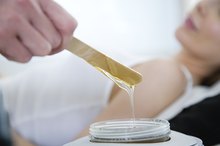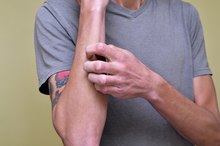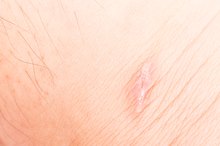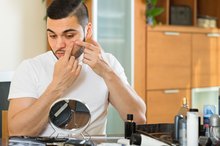What does fact checked mean?
At Healthfully, we strive to deliver objective content that is accurate and up-to-date. Our team periodically reviews articles in order to ensure content quality. The sources cited below consist of evidence from peer-reviewed journals, prominent medical organizations, academic associations, and government data.
The information contained on this site is for informational purposes only, and should not be used as a substitute for the advice of a professional health care provider. Please check with the appropriate physician regarding health questions and concerns. Although we strive to deliver accurate and up-to-date information, no guarantee to that effect is made.
How to Remove an Indented Scar
Indented scars, or “ice-pick” scars, commonly result from acne outbreaks. Proper acne treatment can help prevent some scarring, though in severe acne cases indented scarring is almost inevitable. However, there are treatment methods available to remove ice-pick scarring. You cannot fully erase all evidence of an indented scar, but you may be able to reduce its appearance dramatically. Treatment differs depending on the size and depth of the scar 1.**
Undergo dermabrasion treatment. Provided at your dermatologist's office, dermabrasion uses a rotating abrasive brush to peel away the topmost layers of skin. With the scarred skin removed, new skin grows in its place for less noticeable indentation in the damaged area. Dermabrasion works best on shallow indented scars, according to the Mayo Clinic 1.
How to Remove Scars After Waxing
Learn More
Undergo a chemical peel treatment. Chemical peels are similar to dermabrasion therapies, facilitating new skin growth by chemically removing the topmost layers of skin. The depth of a chemical peel can be controlled by the doctor administering the treatment, but in most cases shallow scars are best suited for this treatment 1. According to the University of Chicago Medical Center, chemical peels are useful for pigmentation problems as well as scars 2. If your scarred skin is discolored, this is a good treatment option.
Get collagen injections at the scar sites. Indented scars can be minimized by puffing up the indentation with collagen. This smooths the skin surface for a less noticeable scar, but any previous discoloration will remain. This treatment works well, but it is temporary. You will need new injections every 3 to 12 months, according to the University of Maryland Medical Center 2.**
How to Remove Hyperpigmentation Scars
Learn More
Undergo laser resurfacing therapy. Laser therapy burns away scarred skin, allowing new skin to grow in its place. Because of its precise accuracy, laser therapy can treat much deeper scars than dermabrasion or chemical peels. However, laser therapy can cost thousands of dollars, and it is not covered by most insurance companies if it for cosmetic purposes.
Remove the scar surgically. During surgical scar removal, the scar is cut out and the remaining skin is sutured together to leave behind a small surgical scar. Because a surgical scar results from the procedure, surgical options are not practical for very small or shallow indented scars. However, for deep indented scars over an inch long, the surgical scar is often less noticeable than the original scar.
Related Articles
References
- Mayo Clinic: What's The Best Treatment for Acne Scars?
- University of Chicago Medical Center: Acne
- Saint-jean M, Khammari A, Jasson F, Nguyen JM, Dréno B. Different cutaneous innate immunity profiles in acne patients with and without atrophic scars. Eur J Dermatol. 2016;26(1):68-74. doi:10.1684/ejd.2015.2713
- Archer CB, Cohen SN, Baron SE. Guidance on the diagnosis and clinical management of acne. Clin Exp Dermatol. 2012;37 Suppl 1:1-6. doi:10.1111/j.1365-2230.2012.04335.x
- Woolery-lloyd H, Kammer JN. Treatment of hyperpigmentation. Semin Cutan Med Surg. 2011;30(3):171-5. doi:10.1016/j.sder.2011.06.004
- Hedelund L, Haak CS, Togsverd-bo K, Bogh MK, Bjerring P, Haedersdal M. Fractional CO2 laser resurfacing for atrophic acne scars: a randomized controlled trial with blinded response evaluation. Lasers Surg Med. 2012;44(6):447-52. doi:10.1002/lsm.22048
- Hedelund L, Moreau KE, Beyer DM, Nymann P, Haedersdal M. Fractional nonablative 1,540-nm laser resurfacing of atrophic acne scars. A randomized controlled trial with blinded response evaluation. Lasers Med Sci. 2010;25(5):749-54. doi:10.1007/s10103-010-0801-1
- Kim EK, Hovsepian RV, Mathew P, Paul MD. Dermabrasion. Clin Plast Surg. 2011;38(3):391-5, v-vi. doi:10.1016/j.cps.2011.05.001
- Wollina U, Goldman A. Fillers for the improvement in acne scars. Clin Cosmet Investig Dermatol. 2015;8:493-9. doi:10.2147/CCID.S86478
- Fabbrocini G, Annunziata MC, D'arco V, et al. Acne scars: pathogenesis, classification and treatment. Dermatol Res Pract. 2010;2010:893080. doi:10.1155/2010/893080
- Alexiades M. "Laser and Light-Based Treatments of Acne and Acne Scarring." Clinics in Dermatology. 2017 Mar - Apr;35(2):183-189.
- Fife D. "Evaluation of Acne Scars: How to Assess Them and What to Tell the Patient." Dermatologic Clinics. 2016 Apr;34(2):207-13.
- Werschler WP, Few JW, Jacob CI, Joseph JH, Spencer JM, Taub AF. "Advancing the Care of Post-Acne Scarring: Expert Insights Into New Treatment Options." Journal of Drugs in Dermatology. 2016 May 1;15(5):518-25.
- Zaleski-Larsen LA, Fabi SG, McGraw T, Taylor M. "Acne Scar Treatment: A Multimodality Approach Tailored to Scar Type." Dermatologic Surgery. 2016 May;42 Suppl 2:S139-49.
- Zouboulis CC, Bettoli V. "Management of Severe Acne." British Journal of Dermatology. 2015 Jul;172 Suppl 1:27-36.
Writer Bio
Richard Kalinowski began writing professionally in 2006. He also works as a website programmer and graphic designer for several clients. Kalinowski holds a Master of Fine Arts from Goddard College and a Bachelor of Science in education from the University of Wisconsin-Whitewater.









